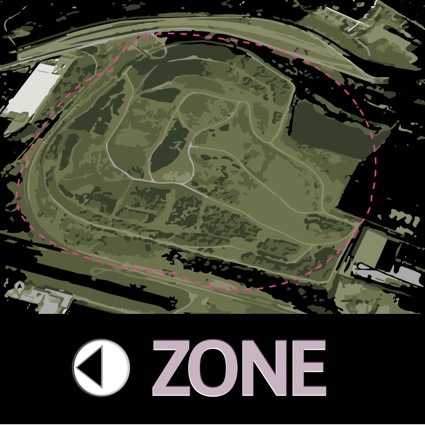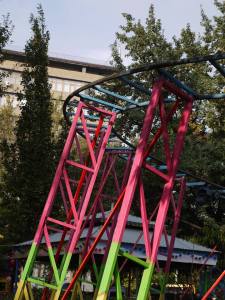Re post form: We Make Money Not Art
Science Fiction: New Death seeks to provoke the question – have the Sci Fi visions we once imagined of the future since become a reality? I guess we all know the answer to that one.

Dario Solman, Target Orbit

Jon Rafman, Hope Springs Eternal/Still Life (BetaMale)
Because i write mostly about art and science/technology, i’ve seen my fair share of exhibitions that reference scifi. However, FACT‘s latest show is the first one i’ve visited that is entirely dedicated to science-fiction and visual arts. And in this instance, science fiction isn’t explored as the ultimate future forecaster, it is rather the starting point of a reflection on our current condition, an invitation to explore how our relationship with technology has made our everyday lives increasingly look like it is set against the backdrop of a science fiction novel.
Inspired by the work of J.G. Ballard, our story looks to the bleak, man-made landscapes of the future and asks: What happens when virtual environments become indistinguishable from reality? Will our global culture allow us to choose where to live, and who will stop us? What will we do with knowledge that becomes freely available to all? With social platforms acting as camera, how will ‘selfies’ develop and what new forms of narcissism will thrive? What is it that we need to preserve, and what do we need to change? These questions are explored through intense visualisations of electronic communication, dystopian domestic interiors, and re-enactments of historical revolutionary moments.
New Death, a title which comes from a text that fantasy writer China Miéville wrote for the exhibition, is ominous but so are the glimpses that the participating artists give into the techno-mediated we’ve built ourselves: conditions of intensified surveillance and repression, border control, loss of citizenship, etc. Not everything is bleak and joyless in the show though. You can bounce off a trampoline and pretend you’re an astronaut, meet intelligent robots that attempt to avoid boredom at all costs, you can even participate to the exhibition by writing a story describing a dystopian near future. I don’t know what a sci-fi fan would make of the exhibition but i found it smart, provocative and thought-provoking.
Quick overview of the show:

Petra Gemeinboeck and Rob Saunders, Accomplice. Installation at FACT Liverpool as part of Science Fiction: New Death

Petra Gemeinboeck and Rob Saunders, Accomplice. Installation at FACT-Liverpool as part of Science Fiction: New Death

Petra Gemeinboeck and Rob Saunders, Accomplice. Installation at FACT-Liverpool as part of Science Fiction: New Death

Petra Gemeinboeck and Rob Saunders, Accomplice. Installation at FACT-Liverpool as part of Science Fiction: New Death
Accomplice is a small clique of social autonomous robots hidden behind one of FACT’s gallery walls. Because these machines are curious, they attempt to discover their environment and the first step to live new adventures is to break down the wall. Their mechanical arm relentlessly punches against the wall. In the process, they not only make holes, they are also acquiring knowledge: how the wall react to their poking, how to best expand their horizon and what it is like out there, on the other side of the wall.
As the wall disappears, the robots discover other creatures: the gallery visitors. The more they can see and hear, the more excited and active these robots are getting. Their behaviour, however, isn’t predictable and linear. As soon as the movements and noises made by the visitors or the colours and patterns they are wearing have become too familiar, the robots become bored. In a sense, the roles usually taken by the audience and the robots or the artefacts and the visitors are reversed: the robots are the spectators and the gallery goers perform for them.
I had a chance to talk with Rob Saunders at the press view. I scribbled our conversation on a bit of paper, lost it so i’m going to point you to this Robots Podcast: Curious & creative in which he talks about being inspired by Gordon Pask’sconversation theory, designing curious systems, the laws of novelty and the social structure that might evolve from them.

The Kazimier
The bits and pieces of walls laying unceremoniously on the floor and the unpredictable attitude of the Accomplice robots echo the exhibition experience that Venya Krutikov & Michael Lill of The Kazimier have designed for Science Fiction: New Death. They turned the FACT building into a disordered, stern and slightly disquieting space to navigate. Your movements inside the gallery might or might not be filmed. That poorly-lit corridor might be off limit. That door over there might open on another artworks or maybe it’s a dead end.

Sascha Pohflepp, Camera Futura

Sascha Pohflepp, Camera Futura

Sascha Pohflepp, Camera Futura
Before Neil Armstrong and Buzz Aldrin walked on the Moon in 1969, the NASA elaborated various exercises to understand how man would move in microgravity. The experiments were not just simulations but “pre-enactments” of a new set of rules that we were about to enter, providing a window into the future through which NASA researchers collected not only data but also visual impressions. One suchexperiment was conducted at Stanford University in the mid-1960s by Thomas R. Kane. The applied mechanics professor had studied the ability of cats to spin their body mid-air so that they could securely land on their four paws. Kane would film a cat bouncing on a trampoline, study its movements, and then a gymnast in a spacesuit would try to reproduce the cat’s movements on the trampoline.
Sascha Pohflepp’s Camera Futura enables visitors to replicate the experiment. You are invited to wear a light space suit and jump on the trampoline while a camera captures your moves.
The energy stored in the trampoline’s springs amplifies the power of our muscles, so that we can briefly launch ourselves and experience an instant of relative weightlessness when falling back to Earth. Camera Futura captures images from that very instant. These photos allow for a glimpse of our brief moment in a post-gravity world. In a sense, they are impressions of ourselves from one of many futures.

Jae Rhim Lee, Infinity Burial Project Installation at FACT Liverpool as part of Science Fiction: New Death

Jae Rhim Lee, Mushroom Death Suit #2
The Infinity Burial Project is an art project with an aim to help us accept the reality of our own death. It is also a very bold and practical alternative to current burial system. Once buried or cremated, our bodies do not just decompose and vanish, they also contribute to the deterioration of the environment by releasing the toxic pollutants that our bodies have accumulated over the course of the years: pesticides, preservatives and heavy metals such as lead and mercury.
Mushrooms, on the other hand, can detoxify soils.
Jae Rhim Lee has thus developed the Mushroom Death Suit, a burial suit infused with mushroom spores to assist the decomposition of human corpses. The outfit comes with capsules that contain infinity mushroom spores and other elements that speed decomposition and toxin remediation. Besides, an open source burial container, and a membership society devoted to the promotion of death awareness and acceptance and the practice of decompiculture (the cultivation of decomposing organisms).

Zach Blas, Facial Weaponization Suite
Facial Weaponization Suite is a playful but also dark critique of the silent and gradual rise of the use of biometric facial recognition software by governments to monitor citizens.
During a series of workshops, Zach Blas worked with members of specific minority communities (queers, black people, etc.) to create masks that are modeled from the aggregated facial data of participants. The amorphous and slightly sinister masks are then worn in public performances.
Masks remain an effective tool to prevent identification technologies from capturing, analyzing, archiving and identifying our face. The use of mask also refers to social movements that use masks as a sign of protests. From the Zapatista rebels, to Pussy Riot, Anonymous, etc.

Brad Butler and Karen Mirza, Deep State Installation at FACT Liverpool as part of Science Fiction: New Death

Brad Butler and Karen Mirza, Deep State. Installation at FACT Liverpool as part of Science Fiction: New Death

Brad Butler and Karen Mirza, Deep State. Installation at FACT Liverpool as part of Science Fiction: New Death (photo FACT)
Brad Butler and Karen Mirza are presenting Deep State, a film scripted by science fiction author China Miéville. The film takes its title from the Turkish term “Derin Devlet,” meaning “state within the state,” and tells a story about the representation of political struggle, moments of crisis, solidarity, schisms and oppression.
The whole film, which overlays archive protest footage and performed interludes, is online:
At first, i wasn’t sure what to make of it but, as the images rolled on, i started connecting them to what was going on in Ukraine at the time of the press view of the show and i realized that at this very moment, maybe we still have a choice: we can be the people who raise their heads, protest and attempt to take some control back or we can be the people who are blindly herded into a society of control.

James Bridle, Homo Sacer, 2014. Installation at FACT-Liverpool as part of Science Fiction: New Death

Close and Remote, Zone

Laurence Payot, 1 in a Million You

Mark Leckey, Pearl Vision. Installation at FACT-Liverpool as part of Science Fiction: New Death




 When the Australian composer and producer Ben Frost released his fifth album, “A U R O R A”, earlier this year the reviews were rapturous. Rolling Stone called it “unrelentingly menacing”, Drowned in Sound said it was a piece of “aural suffocation” (in a good way), and both picked it as “Best Album of the Year So Far”. Frost, though, is more low-key. His albums, he has said, are “over-glorified business cards”—adverts which get him well-paid commissions (he has written music for ballet, opera and film) and bring audiences to his live shows. He has been touring “A U R O R A” since April, and is playing six nights in Britain next week. It’s only live that you hear the album’s terrifying architecture. Listening to it on headphones is like reading a book about brutalism: it doesn’t do justice to its scale and weight.
When the Australian composer and producer Ben Frost released his fifth album, “A U R O R A”, earlier this year the reviews were rapturous. Rolling Stone called it “unrelentingly menacing”, Drowned in Sound said it was a piece of “aural suffocation” (in a good way), and both picked it as “Best Album of the Year So Far”. Frost, though, is more low-key. His albums, he has said, are “over-glorified business cards”—adverts which get him well-paid commissions (he has written music for ballet, opera and film) and bring audiences to his live shows. He has been touring “A U R O R A” since April, and is playing six nights in Britain next week. It’s only live that you hear the album’s terrifying architecture. Listening to it on headphones is like reading a book about brutalism: it doesn’t do justice to its scale and weight.


























































































